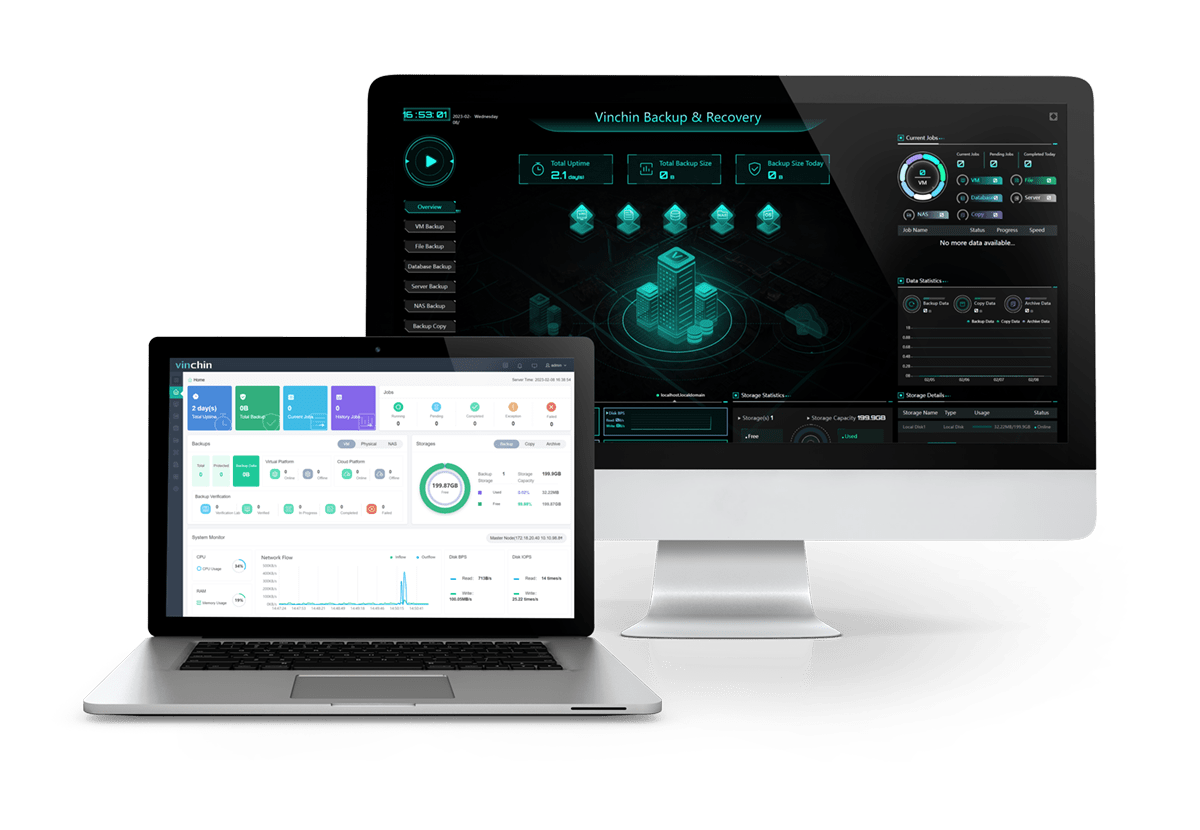-
What is an Enterprise Disaster Recovery Plan?
-
Why Your Business Needs an Enterprise Disaster Recovery Plan
-
Key Elements of Enterprise Disaster Recovery
-
The Difference between Backups and Disaster Recovery
-
How should Enterprises Plan for Data Backup?
-
4 Models of Enterprise Backup and Disaster Recovery
-
What to Consider when Choosing an Enterprise Disaster Recovery Plan?
-
Steps to Build an Enterprise Disaster Recovery Plan
-
Choosing an Enterprise Backup and Disaster Recovery Solution.
-
Sum up
With the continuous development of information technology, the business systems of enterprises are constantly expanding. Their data scale, both in terms of volume and data types, are becoming increasingly massive. So more attention should be paid to data protection. Once natural disasters, man-made disasters, hacker attacks and other emergencies occur, it will have a major impact on the economic interests and reputation of the enterprise. Therefore, establishing a disaster recovery plan is an indispensable part of enterprise management.
What is an Enterprise Disaster Recovery Plan?
An enterprise disaster recovery plan serves as a roadmap for protecting an enterprise's IT infrastructure and recovering it when full protection isn’t possible. More than just an offsite data center or a collection of data recovery tools, disaster recovery plans (DRPs) document the policies and procedures that an organization’s IT workers should know and follow.
When a business encounters a physical or digital disaster, IT personnel need a detailed plan that they can immediately implement. The fewer questions they need to ask and the more quickly they can take action, the sooner IT teams can bring systems back online or restore lost data.
Why Your Business Needs an Enterprise Disaster Recovery Plan
Ø Limit the impact of unforeseen incidents.
Ø Keep services and operations active in times of crisis.
Ø Minimize revenue losses.
Ø Enable smooth and quick system restoration.
Ø Help the team stay calm when disaster strikes.
Key Elements of Enterprise Disaster Recovery
In any case, the primary purpose of backup and disaster recovery is data security. To quickly restore the business in the event of a failure, all designs must serve this ultimate goal. In enterprise disaster recovery, the following concepts should be paid attention to:
Business Continuity: Business continuity is a business’s level of readiness to maintain critical functions after an emergency or disruption.
Business continuity deals with how to respond to disruption events, and disaster recovery planning focuses on solving the root problem, whether it is a data breach, system failure, or other accident. Therefore, it focuses more on the immediacy of contingencies and often coincides with business continuity.
RPO:Recovery Point Objectives can be understood as the time measurement from the loss event to the last previous backup.
RTO:Recovery Time Objectives is understood as how much time can be interrupted or shut down without causing significant damage to the business.
In order to achieve the RPO and RTO of the business system, enterprises need to use a combination of a series of technologies including backup, not just backup technology in a narrow sense.
The Difference between Backups and Disaster Recovery
Disaster recovery must include backup, but backup alone is not equal to disaster recovery. A destructive ransomware attack can render an enterprise’s computers unusable. So even though lost files can be recovered from backups after a disaster, businesses cannot quickly resume operations because there is no infrastructure to consume them. This will make all separate recovery measures redundant.
Disaster recovery is not just about recovering data, but being able to efficiently and quickly get the business recovered and running. With the increasing diversity of business models, disaster recovery plans need to be more customized. Templates and out-of-the-box agreements are no longer sufficient for most businesses.
As mentioned above, data backup is the cornerstone of disaster recovery, but many enterprises are still figuring out this crucial step.
How should Enterprises Plan for Data Backup?
1. Researchig backup demand
There are many types of data in enterprises, and the types of data in different industries may vary widely. But from the perspective of backup software, the data that needs to be backed up is nothing more than the following: files, operating systems, databases, emails , ERP system, virtual machines, HCI, big data, cloud computing platforms, NAS and containers.
Through backup demand research, you can confirm the backup object. In this way, you can know the number of production systems and hosts, types and amount of data, operating systems of hosts, backup window, etc.
Further more, you can get the requirements o backup storage, backup speed, needed modules, backup levels, backup schedules, etc.
2. Planning the backup system
After collecting the backup requirements of the business system, it is necessary to carry out an overall backup plan according to the actual situation and the backup requirements of each business system. Generally speaking, it is divided into the following parts:
Strategy planning: This refers to the classification of each business system, and then the backup software divides business data into different strategies according to the classification for centralized backup management. In general, the content of the policy will include the host, backup data, backup frequency and backup retention period, etc. Strategic planning should start from actual needs and refer to its own RPO and RTO indicators to complete the design. It is necessary to avoid insufficient design, which fails to meet the recovery requirements; at the same time, it is also necessary to avoid over-design, which wastes precious storage and computing resources.
Scheduling planning: This refers to the initiation window of the business system backup job. Different business systems have their own characteristics, and the impact of backup jobs on business systems must be fully considered during scheduling design.
Storage planning: The planning of backup storage needs to be considered from two dimensions:
Backup network: It can be said that the key factor affecting the performance of the entire backup system is the backup network. Insufficient design of the backup network will lead to a series of performance problems, which will eventually lead to substandard RPO and RTO.
Backup storage: The storage of the backup system mainly includes disk storage, tape storage and cloud storage. Enterprises should choose the appropriate storage method according to their business needs.
Disaster recovery planning: Usually, the backup we mentioned refers to the local backup system. However, for many enterprises, there are multiple data centers, and disaster recovery mechanisms such as synchronous, asynchronous, or active-active may be implemented among these data centers. In the long run, the planning and design of the backup system must also keep up with the disaster recovery planning of the enterprise.
4 Models of Enterprise Backup and Disaster Recovery
Regarding backup and disaster recovery, there are the following design patterns:
1. Backing up the main center to the tape library, and regularly releasing the tapes, transporting the tapes to the backup center for storage. The backup center can optionally design a backup system for recovery verification. Strictly speaking, this can only be regarded as off-site storage of backup media, not disaster recovery.
2. Deploying the backup system independently in the main and backup center. In the case where the main and backup centers have already synchronized data based on the business or data level, this method actually deploys two sets of independent backup systems, which are independent both in terms of data and architecture.
3. The primary and backup centers use the same backup storage, and data synchronization is performed based on the backup storage level. The backup software directly uses the synchronized data. In this way, the backup software is deployed independently, but the backup data is associated with replication.
4. The primary and backup centers use the same backup software platform, and have implemented data synchronization based on the backup software. Generally, the synchronization will reduce the amount of data transmission based on deduplication and compression technologies.
There is no specific example of which disaster recovery backup mode to use. It is necessary to choose the most suitable one in combination with the actual situation of the enterprise itself. In addition, the planning for backup and disaster recovery can be done in a long-term and phased manner, and it does not need to be completed overnight.
You can click this article to read more about the types of disaster recovery.
What to Consider when Choosing an Enterprise Disaster Recovery Plan?
The IT environment and its unique requirements.
Which assets need to be protected (digital and physical).
Industry risk level.
Preferred method for backup and restore.
Total budget.
Steps to Build an Enterprise Disaster Recovery Plan
1. Create a disaster recovery team.
2. Identify and assess disaster risks.
3. Determine critical applications, documents, and resources.
4. Specify backup and off-site storage procedures.
5. Test and maintain the DRP.
Here is a disaster recovery plan checklist to help you perfect your plan.
Choosing an Enterprise Backup and Disaster Recovery Solution.
As a professional data protection solution provider, Vinchin owns the leading disaster recovery technology to all kinds of data security problems and provides reliable disaster recovery solutions to every enterprise client.

Vinchin Backup & Recovery is a professional solution which supports data backup of VM like VMware vSphere, Hyper-V, XenServer, XCP-ng, oVirt, RHV, OpenStack, etc. and other data like database, NAS, file server, etc.
By using Vinchin Backup & Recovery, you can instantly recover the entire VM and all its data from any restore point (no matter it's a full backup, incremental backup or differential backup) to quickly recover failed server from downtime. It is an excellent solution to ensure business continuity, minimize the loss of crucial business interruption caused by disaster or system failure.
Vinchin Backup & Recovery has been selected by thousands of enterprises for disaster recovery and you can also start to use this powerful system with a 60-day full-featured free trial. Just click the button to get the installation package.
Sum up
In short, the formulation and implementation of a disaster recovery plan is not only an important guarantee for the enterprise IT infrastructure, but also a strong support for the sustainable and stable development of the enterprise. Enterprises should actively strengthen the formulation and implementation of disaster recovery plans to ensure the security and overall stability of information assets, and at the same time improve the early warning and disposal capabilities for uncontrollable factors such as natural disasters and human errors, and provide guarantees for enterprise development.
Share on:








